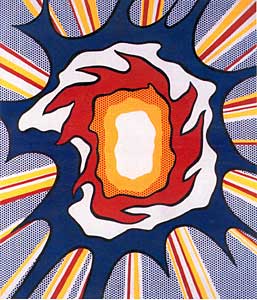Roy Lichtenstein
Recognizable Images
Roy Lichtenstein (New York 1923-1997) is considered one of the most important American artists of this century. By blending popular images with western stylistic traditions, Lichtenstein succeeded in establishing a unique style. He studied under the influence of Abstract Expressionism at Ohio State University, but his early works surprisingly reflect a great attachment to figuration and a curious interest in the origin of American culture. The search for a new language very soon led Lichtenstein to experiment with images salvaged from popular culture, thus creating his first cartoon works, which now constitute the beginnings of Pop Art. These mundane scenes by Lichtenstein were handmade, but they set out to follow the technical principles of mechanical reproduction used in newspapers and comic strips, such as superimposed patterns of dots, which, despite creating uniform surfaces, give tone values to images and were soon to become the hallmark of his work. His mechanical, two-dimensional world of figures enlarged many times beyond their original size and featuring thick outlines, bright colours and stylised shapes constitutes a wise and thoroughly identifiable reinterpretation of everyday life. His widely reproduced pictorial scenes now form an essential part of our artistic memory, but it is important to add another recollection: that of his striking sculptural work, much less publicised but to which from the outset he devoted an important place in his development, which is precisely what we wish to highlight with this exhibition. The marked correspondence between the pictorial and sculptural work that we now know started in the sixties when, having acquired a more defined plastic language, Lichtenstein decided to lay the foundations for his sculpture in the repertoire of images drawn from his two-dimensional work, a resource that from then on became a constant feature in his development as a sculptor. That is why his sculptures frequently present elements characteristic of his paintings, such as black outlines or drawn shadows that give a sensation of depth. It was during those years that he made his heads of women and, later, cups, plates, spoons and teapots and his explosions in relief, which perhaps provide the clearest example of three-dimensional transformation of an idea previously conceived in two dimensions. After the explosions came his so-called Modern Sculptures, consisting of a combination of lines and surfaces, flat or curved, which derive from international Minimalism and Art Déco combined with the designs for some of his works of the sixties and seventies. After a relative pause lasting from about 1970 to 1976, Lichtenstein resumed his sculptural work with new momentum, this time focusing on the recreation of striking objects taken from his drawings or paintings and portraying, in almost flat form, his earlier versions of mirrors, cups, glasses, desks, lamps and tables. In the eighties he shifted away from the conventional themes of his work and concentrated mainly on profiles of heads—incorporating elements ranging from German Expressionism to ancient Greek pottery—and on his so-called Brushstrokes, which were initially almost devoid of volume and then increasingly projected into space, parodying the impulsive gesturalism of the artists of Action Painting. Finally, in the nineties, besides continuing with his Brushstrokes and embarking on his static mobiles which evoke the famous artist Alexander Calder, he devoted himself to experimenting with new materials such as galvanised steel, tin, pewter and iron moulds, porcelain and wax, in order to make his sculptures of domestic interiors and exteriors of houses. Humour and distance particularly characterise the work of Lichtenstein, for whom any theme can become an element for reflection.



